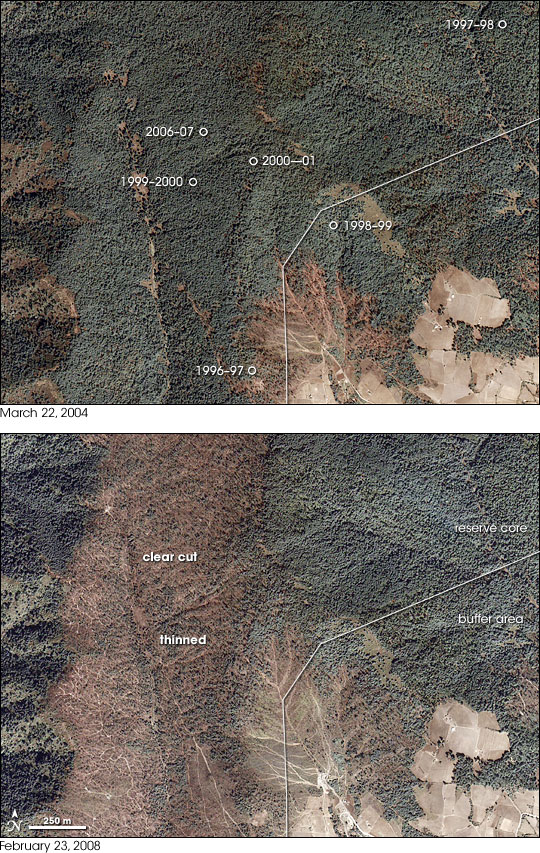|
==============================================================================
TOPIC: Monarch Butterflies
http://groups.google.com/group/entstrees/browse_thread/thread/ab9de423b2509d35?hl=en
==============================================================================
== 1 of 4 ==
Date: Thurs, Mar 13 2008 3:46 pm
From: "Edward Frank"
ENTS,
How many of you have tried raisng Monarch Butterflies from
caterpillars? They are one of the species more amenable to this
activity and a good way to get children of all ages involved in this
one aspect of nature activities. They can be found as
white-orange-and-black banded caterpillars living on milkweed
plants. What is particularly neat about this species is that
populations migrate south and overwinter in Mexico.
Bad news is that the "protected" overwintering grounds in
Mexico are being severely impacted by illegal logging. There are new
satellite photos and information on this problem on NASA Earth
Observatory website: http://earthobservatory.nasa.gov/Newsroom/NewImages/images.php3?img_id=17943
The article reads in part::
Recently, scientists identified severe degradation of the forest
habitat within the Monarch Butterfly Biosphere Reserve in central
Mexico using imagery from the commercial Ikonos satellite. The white
line indicates the boundaries of the reserve's "Core
Zone," where logging is forbidden according to the Presidential
decree that established the reserve in November 2000. This pair of
images shows the affected area on March 22, 2004 (top) and February
23, 2008 (below). The degraded area is the site of the Lomas de
Aparicio monarch colony. The circles on the image (not to scale)
indicate the approximate positions of the colony in different
seasons. Colonies typically cover areas of 0.25-2.0 hectares
(equivalent to a circle with a diameter of 60-160 meters, or 200-525
feet). The area had been largely intact since at least 1986.
Overwintering colonies have been documented there since 1996, but
have probably formed there long into the past.

In the 2004 image, the beginnings of the logging operation are
apparent in an area to the east of (and partially inside) the core
zone. Based upon this pair of images, and a similar image taken in
2006 by the QuickBird satellite, scientists Lincoln Brower, Daniel
Slayback, and Isabel Ramirez have determined that approximately 450
hectares (1,110 acres) of forest were logged between 2004 and 2008,
representing 3.3% of the 13,552 hectares (33,410 acres) core zone of
the reserve. The majority of this logging (290 hectares, or 717
acres) has occurred since March 2006.
Forest degradation-which progresses from thinning to
clear-cutting-has been an ongoing problem throughout the reserve.
Other logging incursions have destroyed several other prime
overwintering areas within the reserve, making them unsuitable for
monarch colonies. Based upon the degradation apparent in these
images, it is unlikely monarchs will form overwintering colonies at
this Lomas de Aparicio site in future years. If they do return, they
will be subject to much greater environmental risks during their
six-month overwintering stay. An intact forest canopy serves a
critical role by protecting the monarchs from both freezing cold
during winter storms and from excessive warmth during the days
Ed Frank
== 2 of 4 ==
Date: Thurs, Mar 13 2008 5:48 pm
From: Larry
ENTS, And the beat goes on as mankind continues to destroy the
environment for greed! To hr# with a Butterfly lets make
money! Didn't the US clear all our forests regardless
of the consequences! We only wiped out the whole ecology of the
United
States how many species did that
effect?
In Northwest Fla., I watched hundreds of Monarchs daily as they
stopped on their Migration route. Thanks for sharing that Ed. Larry
== 3 of 4 ==
Date: Thurs, Mar 13 2008 6:02 pm
From: "Edward Frank"
ENTS,
To Mexico's credit, they did declare this a World Biosphere Reserve
and make logging there illegal. The problem with reserves in poorer
countries, is that while they may legally be protected, their
governments do not have any or are unwilling to spend the money
needed to enforce their legal protection. There is corruption in
some cases to be sure (like in the United States), but often the
developers, mining companies, timber companies, and drug dealers
simply have more funds to pursue their activates than the government
has to stop them.
Ed
== 4 of 4 ==
Date: Thurs, Mar 13 2008 9:58 pm
From: James Parton
Ed,
In my younger days I gathered both caterpillars and eggs from
milkweed
plants, the preferred the bright orange butterfly weed the most. All
you had to do was keep the little striped caterpillars fed and they
would grow and then pupate into a beautiful green & gold
crysalis.
After a couple of weeks or so the crysalis would darken and you
could
see the butterfly inside. It would emerge, dry its wings and then
fly
off. I raised many species of lepidoptera this way. The Monarch and
Silk Moths ( Luna, Cecropia, Promethia, Polyphemus, etc ) are my
most
memorable.
James P.
|